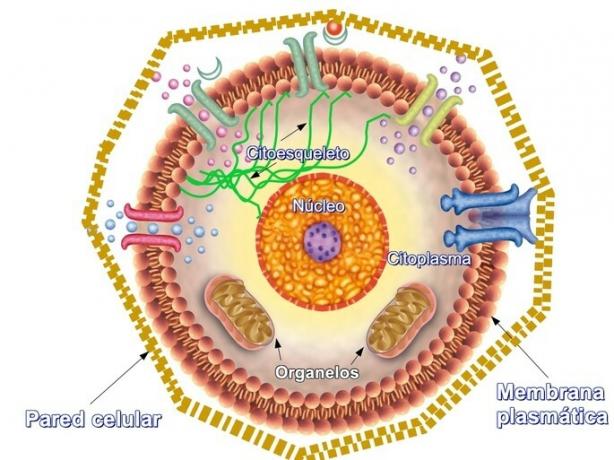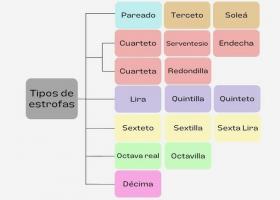The main parts of the cell and their function
The cell is the basic unit of living things. The main parts of the cell are:
- plasma membrane
- Cytoplasm
- Cell nucleus
- Cellular wall
- organelles
- cytoskeleton

| cell part | Characteristic | Function |
|---|---|---|
| plasma membrane | Present in all cells. |
Allows the passage of nutrients. Limits the interior content of the cell. Receive external signals. |
| Cytoplasm | Present in all cells. Made up of water, ions, proteins. |
Allows chemical reactions. |
| Cell nucleus | Present only in eukaryotic cells. Made up of membrane, nucleic acids and protein. |
Keeps the genetic code protected. |
| Cellular wall | Present in plant cells, fungi and bacteria, although with different compositions. | Protects the cell from dehydration. |
| organelles | Present in eukaryotic cells. |
They specialize in different cellular functions. |
| cytoskeleton | Mesh or network of proteins that form filaments. | It gives shape to the cell. It allows the movement of the organelles and the cell. |
plasma membrane
The plasma membrane is the structure that encloses and limits the cellular content. This acts as a selective barrier, that is, it allows certain substances to pass while preventing the passage of others. In addition, it is through the membrane that the cells communicate with each other and detect external conditions.
All prokaryotic and eukaryotic cells have a plasma membrane. It is made up of 50% lipids and 50% proteins. The main lipids are phospholipids, sphingolipids and sterols.
Phospholipids are characterized by being amphipathic, that is, one part of the phospholipid has an affinity for water, while the other does not. This allows the phospholipids to group together to form sheets or layers where the water-related parts are on the outside and the hydrophobic parts are hidden, forming a lipid bilayer.
The lipid bilayer is the scaffolding of the membrane. Molecules of other lipids are embedded between the phospholipids, such as cholesterol in animal cells and phytosterol in plant cells.
Membrane proteins perform the most important tasks of the plasma membrane. Some proteins cross the membrane from the inside to the outside, these are the transmembrane proteins. For example, membrane transport proteins, which determine which molecules enter the cell, become embedded in the membrane.
Other proteins are just on one side of the membrane, either inside or outside the cell. These are known as peripheral membrane proteins.

You may also be interested in seeing Cell types.
Cytoplasm
The cytoplasm is the interior space of the cell, where the organelles are found floating in the cytosol. It is characterized by being a continuous gelatinous network, anchored to the plasma membrane and attached to the nucleus. It occupies the entire volume in prokaryotic cells, while in eukaryotic cells it can reach half the cell volume.
The viscosity of the cytoplasm resembles that of water, although quite crowded with macromolecules.
All intracellular activities that are not sequestered within the membrane organelles take place in the cytoplasm. For example, the reactions of glycolysis in cellular respiration take place in the cytoplasm.
You may also be interested in seeing aerobic and anaerobic respiration.
Cell nucleus
The nucleus contains the genome, the genetic material of the cell that is defined in deoxyribonucleic acid (DNA).
The nucleus is bounded by the nuclear envelope, a double membrane with pores. Proteins and ribonucleic acids (RNA) pass through the pores. This envelope disappears during mitosis.
The nucleolus is a structure within the nucleus. It is the site for the processing of rRNA ribosomal ribonucleic acids, which are the components of ribosomes.
The DNA within the nucleus is coiled and packaged to form chromatin.
Cellular wall
The cell wall is a rigid structure that surrounds the plasma membrane on the outside. It is present in bacteria, archaea, fungi and plants.
The cell wall of bacteria is made up of a combination of proteins and sugars known as peptidoglycan. Penicillin and other antibiotics, drugs used to treat infections, have as their target of action to prevent the synthesis of the cell wall.
The cell wall of fungi is made up of glucan and chitin, glucose polysaccharides and acetylglucosamine. This structure gives it mechanical strength and plasticity, which allows the fungus to withstand environmental conditions, while also being able to divide and grow. Their destruction can lead to the death of the fungus.
The cell wall of plants is made up of cellulose, pectin and lignin, polymers of various sugars, such as glucose and galacturonic acid. It functions as a support or skeleton of the plant structure. In addition, it protects each cell individually and allows the transport of fluids in the plant through its channels.
You may also be interested in seeing:
- archaea and bacteria
organelles
Organelles are small structures within the eukaryotic cell that are made up of membrane. Each organelle has characteristic proteins to fulfill specific functions. Among the main organelles we have:
- Ribosomes: are the protein factories of cells. They are found in both prokaryotic and eukaryotic cells.
- Endoplasmic reticulum: is a labyrinth of membranes where proteins and lipids are processed.
- Mitochondria: is the energy production factory for cellular functions.
- chloroplast: are the organelles where photosynthesis occurs in plants.
- Golgi apparatus: are membrane compartments that are responsible for enclosing proteins in vesicles
- lysosomes: is the digestive organelle of the cell. In the lysosomes there are proteins that are responsible for breaking down the material that no longer serves in the cell.
- Peroxisomes: are vesicles that are responsible for oxidation and reduction reactions. They contain enzymes such as catalase and peroxidase.
cytoskeleton
The cytoskeleton is a dynamic system of filaments found within the cell in the cytoplasm. It is responsible for the internal organization of the cell, its mechanical properties and locomotion. Also, it actively participates in mitosis by separating the chromosomes and then dividing the cell in two.
The cytoplasm allows sperm to swim and white blood cells to crawl across surfaces. Muscle cell contraction is produced by the cytoskeleton, as well as dendrite and axon extension in nerve cells.
Animal cells have three types of filaments:.
- intermediate filaments: provide mechanical strength.
- microtubules: determine the position of the membranous organelles.
- actin filaments: determine the shape of the cell surface and are necessary for locomotion
You may also be interested in seeing:
- Parts of the animal cell
- plant cell parts
References
Alberts, B. et al. (2008) Molecular biology of the cell. 5th ed. Garland Science. UK.
Bowman, SM, Free, S.J. (2006) The structure and synthesis of the fungal cell wall. BioEssays 28: 799-808.
Luby-Phelps, K. (2013) The physical chemistry of cytoplasm and its influence on cell function: an update. Molecular Biology of the Cell, 24: 2593


